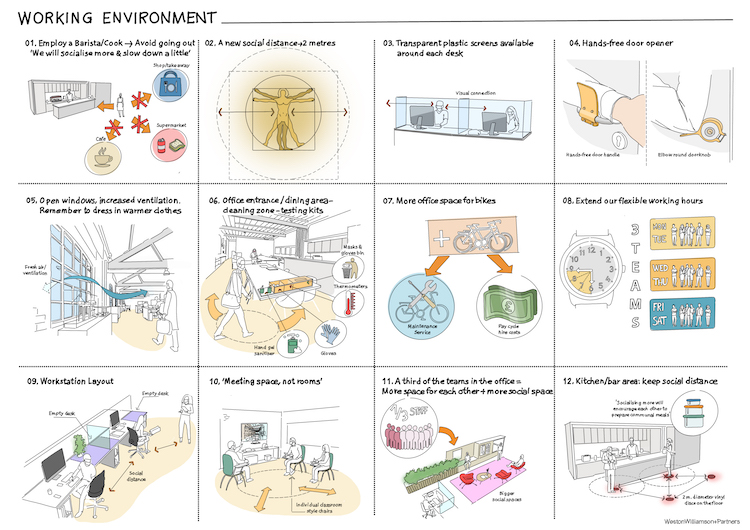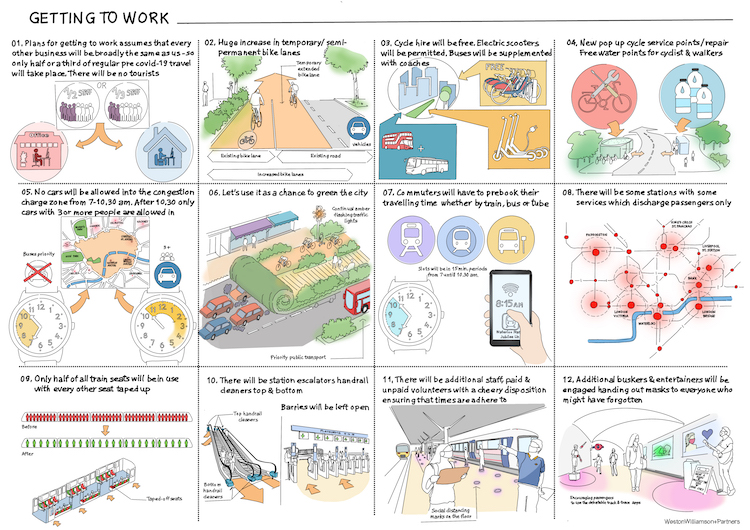Post
Getting Back to Work | Chris Williamson
13 May 2020
Earlier this month Chris Williamson of Weston Williamson + Partners gave us his thoughts on the sort of London that will emerge #WhenThisIsAllOver. Here he addresses some of the practical changes that WW+P are making to allow people back into the office, and looking at what the capital (and particularly the transport infrastructure) might need to do for the city to open up again.
I was extremely disappointed in Boris Johnson's address to the nation on Sunday evening. The address was full of ambiguities which is great if you are trying to keep arguments vague to get people to vote against complicated nuanced issues but not to contain a virus. Telling people to get in their cars and go to work is irresponsible when the Covid related deaths are still in their hundreds a day and cases in the tens of thousands. We need strong and clear messages which are well thought through. The whole of this crisis has seen too many promises and pledges badly thought through. Reassuring people of their safety in returning to work is essential.
Tony Travers of LSE said recently “Getting people out of their homes and back to work may prove especially challenging in Britain, precisely because citizens have learned they need to remain at home to stay safe, protect NHS workers and save lives.”
I’ve been attempting to put together a plan for gradual transitioning to a safe studio environment ahead of a vaccine being available for Covid-19.
So these suggestions might be relevant for many months. At Weston Williamson we have found that we can function with home working but that we work better together. We need to blend the two ways of working, and in the future this may become the new normal.
Architects and designers need to be alive to emotional aspects of any return to work. Not just the practicalities.
My planning involves the studio working space and equally important, getting to work.
I have modelled the plans on Weston Williamson and Partners but have considered how this works for the whole of London.
At Weston Williamson we have information of how everyone travels each day so that makes it easier to plan.
We are also researching individual appetite to return to the studio base, and who can travel safely.
It is important that any return is consensual with no feeling of persuasion one way or another as there will be many variables within this. Family circumstances, personal health, home working conditions etc.
Armed with all this data we are replanning our studio to accommodate 50% of our 100 staff at any one time to allow safe social distancing.
The WW+P studio space is relatively easy to adapt to safe working. We have two side doors which open into the lobby for the washrooms so everyone can wash and change as soon as they enter. The drawings (above - you can download the full images here and here) show other modifications such as holding meetings in open areas rather than closed meeting rooms, and employing a barista and cook rather than having a shared kitchen. The changes will make a more relaxed, calmer sociable studio. The changes will be beneficial. As restaurants, bars, cinemas, theatres and sporting events might be curtailed for some time the working day could be more flexible and relaxed.
The studio will be divided into three teams. The blue team will be asked to work Tuesday and Wednesday. The red team will be asked to work Thursday and Friday.
The following week the teams will change days.
Saturday and Monday will be for Partners and project reviews.
Given all that, there are changes in layout and additional hygiene measures included in the drawings. The key is to do these modifications with style and grace and use these unfortunate circumstances to actually improve how we work with climate change in mind.
Investment in video conferencing and distance working facilities has paid off during the lockdown and we see future investment being essential to allow greater flexible working.
My plans for getting to work assumes that every other business will be doing broadly the same as us - so only half or a third of regular pre covid-19 travel will take place. There will be no tourists. Last year WW+P conducted a major survey on commuter attitudes in 10 global cities so I have incorporated those results into these proposals:-
- No cars will be allowed into the congestion charge zone from 7-10.30 After 10.30 only cars with 3 or more people signing u via a car sharing app. Buses will be supplemented with coaches.
- More space will be given to cycling and walking and greening the city.
- Cycle hire will be free. Electric scooters will be permitted. At Weston Williamson we will fund the purchase of electric cycles.
- Commuters will have to prebook their travelling time whether by train bus or tube. Slots will be in 15 minute periods from 7 till 10.30
- There will be additional staff, paid and unpaid volunteers with a cheery disposition ensuring that times are adhered to.
- Passengers will be managed in groups into the station onto the platforms and onto the trains.
- Additional buskers and entertainers will be engaged handing out masks to anyone who might have forgotten and encouraging passengers to use the debatable track and trace app.
- Only half of all seats will be in use. There will be escalator handrail cleaners top and bottom. Barriers will be left open.
- There will be some stations with some services which discharge passengers only. On the Jubilee Line say only dropping off at Waterloo so passengers alighting would have to go to Southwark or Westminster.
- Other stations such as London Bridge lend themselves well to a one way system enabling social distancing for reduced numbers.
Again the intention is to implement these changes beautifully (unlike the knee jerk additions to terrorist attacks) to consider how we travel to improve our city in the short term and the planet for the long term .
It’s interesting that the very things that attract us to cities - workplace, social gatherings, exchange of ideas, talks, debates, theatre, cinema, galleries, museums - are no longer available to us. Without them what is the city? Thinking further ahead we should consider that this is not a one off hiatus. We should plan for this happening again, next time maybe worse. We should plan our transport and our cities and our economy to build in this resilience and to give choice of where to live, work and relax. If we plan properly it will work, it could even be fun and will make the world a better place.
Lets look back on 2020 as the year a virus made us stay home to reappraise how we live and to make the city better.

